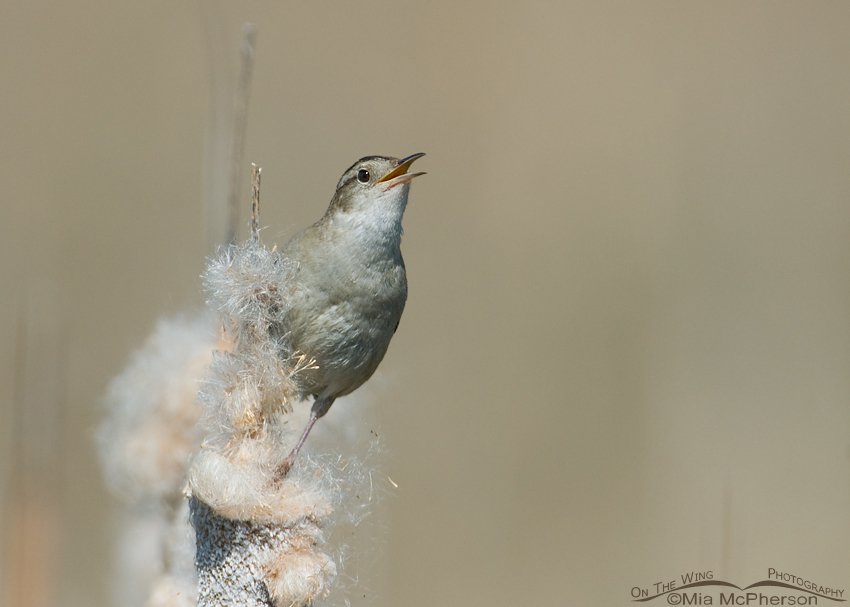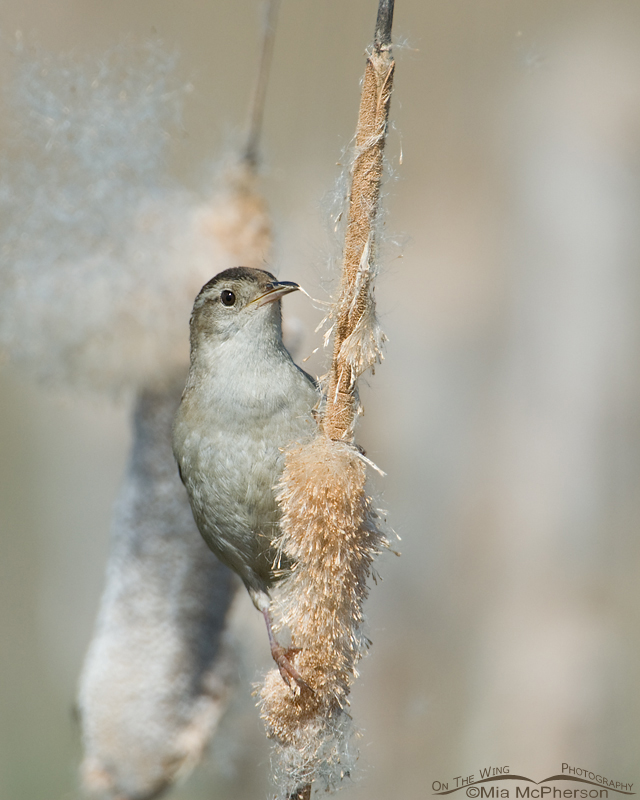 Marsh Wren (Cistothorus palustris) in Cattail fluff – Nikon D200, f6.3, 1/1000, ISO 400, +0.3 EV, Nikkor 200-400mm VR with 1.4x TC at 400mm, natural light
Marsh Wren (Cistothorus palustris) in Cattail fluff – Nikon D200, f6.3, 1/1000, ISO 400, +0.3 EV, Nikkor 200-400mm VR with 1.4x TC at 400mm, natural light
I photographed these male Marsh Wrens during breeding season when they were calling on their territories, while the male and female are alike in most aspects the exception is that only the males sing. And sing they do! Individual western males often have more than 100 songs and they are especially vocal when they are trying to attract a mate.
 Marsh Wren male perched on a Cattail – Nikon D200, f6.3, 1/1250, ISO 400, +0.3 EV, Nikkor 200-400mm VR with 1.4x TC at 400mm, natural light
Marsh Wren male perched on a Cattail – Nikon D200, f6.3, 1/1250, ISO 400, +0.3 EV, Nikkor 200-400mm VR with 1.4x TC at 400mm, natural light
Marsh Wrens are year round residents in Utah except for the northern most portion of the state. They prefer fresh and saltwater marsh habitats where there are grasses, reeds, sedges and cattails present. It can be a challenge to photograph Marsh Wrens in the open but during breeding season the males often perch high on the vegetation while they are singing. They also move very quickly so it can be hard to keep track of them.

Though Marsh Wrens are small in size I find that they have big attitudes. When I lived on the east coast I had Carolina Wrens that nested underneath my kitchen window where my sink was located, when I “dared” to wash my dishes the adult would sit on the windowsill and voice its displeasure. Loudly! That still makes me chuckle.
Marsh Wrens are amusing to observe, photograph and listen to. There is never a dull moment with them.
Mia


Hi!
Thank you for the great photo of the Marsh Wren! Yes I have this Wren coming to my suet hanger!
Have a great week of shooting!
Mia, I found my way over here again through Larry Jordan’s blog … he’d mentioned your Prairie Falcon photos. As I peruse your various blog posts, I’m overwhelmed by the beauty of your shots. I love your philosophy, as well. I’m with you on the methodology — embracing the imperfections of water droplets and capturing animals in their natural behavior, without the bait and so forth. So lovely to make your acquaintance through this blog and through your awesome images.
Ingrid, it is very nice to “meet” you and I’m glad you found my blog. It is wonderful to hear that we share the same thoughts about not baiting, capturing natural behavior and so on. Thank you for your very thoughtful comment on my blog and my images.
That last shot of the Marsh Wren is fabulous Mia! I do love to hear them sing in the Spring. The males also build several nests for the females to choose from, usually a dozen or so. The many nests also help the male mark his territory.
Larry, I should have mentioned that the male Marsh Wrens build a lot of dummy nests. Interesting little birds. Thanks for your comments on my images, as always I really appreciate that.
Again outstanding photos of the Marsh Wren. I absolutely love the bottom image, Mia.
On another note, I have noted you in my post tomorrow, honoring you as a recipient of the Versatile Award. You don’t have to accept it, but you certainly are my number one honoree.
Bob, thank you so much for your kind comment.
I’m looking forward to seeing your post tomorrow, I am honored that you would include me!
Such a fantastic post, I always enjoy being serenaded by this rambunctious birds on a marsh walk!
Thank you Pat, I love hearing these birds too. They are so high energy and amusing.
Wonderful photos Mia, I find them tough to shoot. We have a resident Carolina Wren here, but the House Wrens have the real attitude in spring and summer.
Thanks for your comment Dan, they are tough to shoot!
Wrens have personality, that’s for sure. I like that tail position-it’s sassy! So far, I have yet to see a marsh wren. Got a photo of my first Rock Wren at the Delicate Arch parking lot.
Julie, I saw my first Rock Wren near Moab while camping. There was an open cupcake in the pickup and I guess the wren was checking it out, I opened the door and the wren got scared or something and flew straight at my face! I still laugh about that.
Very nice photos Mia, I didn’t see a Marsh Wren last year, but I’m hoping to see one this year.
Thank you Prairie Birder, I just saw one two days ago and it reminded me to post these images. I hope you get to see yours this year too.